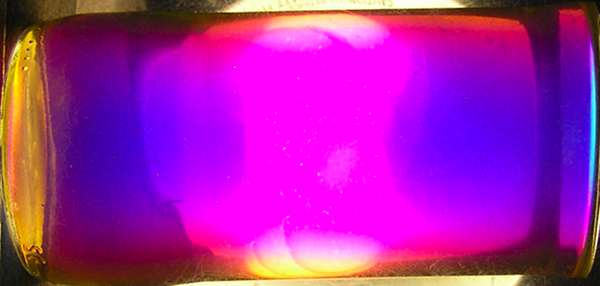Fractional Quantum Hall Effect
The main focus of the FQHE project is understanding how the unpredicted FQHE emerges from the fundamental electron-electron and electron-magnetic field interactions. Between Creighton and SIUE, I've had a total of four undergraduate students work with me on various aspects of the FQHE project - mostly as brief, summer projects. The first phase of the project, a single particle model, gives results broadly consistent with the composite fermion picture for the FQHE but lacking differentiation between even and odd denominator fractions for the ratio of electron density to magnetic field density and producing only half the reduction in the magnetic field expected. The last student, Adam Wuller, began work on phase two of this project which involves working with pairs of the electrons as the basis states rather than single electrons as the phase one model used. This model is now built but not debugged. Assuming this model behaves as expected, the third stage will be to attempt a completely analytical solution with all the electrons interacting with each other. This will be challenging and it is difficult to predict what background a student will need to work on this project, but I hope that a talented student with a strong background in quantum mechanics and linear algebra would find this project challenging and interesting. One approach that I will try is random matrix theory. This is a fascinating area of theoretical physics that has proven very productive in nuclear physics and statistical mechanics and I hope to exploit this for the FQHE.
Una Corda Pedal
Another recent research project, which bears continuation, is the work Danielle Castens did on quantifying the effects of the una corda pedal on the sound coming out of a piano. Danielle's work grew out of a SCI 241 project here at SIUE. As such, we were working with very unsophisticated audio equipment and used readily available analysis methods. I would like to continue this project, with a student, with better equipment and more sophisticated analysis. I would also like to work with a student on modeling how the strings interact with each other to explain the tonal effects. Both of these projects would be quite accessible to undergraduate students. The modeling project would probably extend a students knowledge farther beyond the typical undergraduate curriculum.
Thin Films
I recently attended a seminar on the melting of thin metallic films by pulsed lasers and it occurred to me that the behavior described ought to be amenable to a cellular automata model. This should be a very nice student project. As I envision the project, it wouldn't require a lot of technical background, but would involve two very current research topics.
Musical Instruments and Materials
Another possible project would address the question of whether or not it matters what you make your instrument out of. There is a considerable body of research on this already, but as with many areas, advances in materials and advances in computer technology open up possible avenues of investigation. In particular, I would like to end up with a convincing demonstration, one way or the other, that could readily be done for or with musicians because there is a large gap between the physics community's view of this topic and that of the musicians who play the instruments.
Recumbent Bicycles
Another project which could be either experimental or theoretical involves recumbent bicycles. There is a lab currently doing work on understanding how bicycles really work, but they seem to focus on the traditional diamond frame. I would be interested in extending their work to the recumbent geometry. At a theoretical level, this project would be at about the same level as modeling the effects of the una corda pedal. Experimentally there are several ways the project could go, with substantially different equipment requirements. One would be to study the biomechanics of the frame design and analyzing heart rate, oxygen consumption, and ideally muscle and joint stress as a function of various frame design parameters. Another would be to look at aerodynamics. This is possibly less interesting because more has already been done with this although, again, new designs appear faster than independent labs can do comparisons of them. A third would be to study stability, turning radii, steering effort, and so forth for both the unloaded and loaded frames.
Miscellaneous
Other problems in which I am interested in working on projects with students include other aspects of acoustics (especially producing sound from wind instruments), percolation problems, home-scale solar and wind energy, and hybrid car technology.
